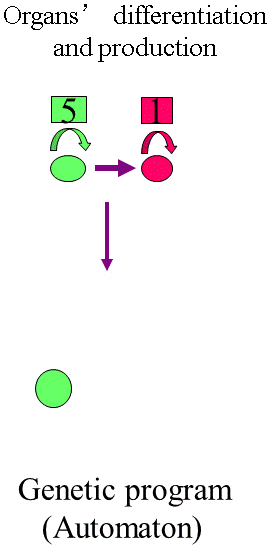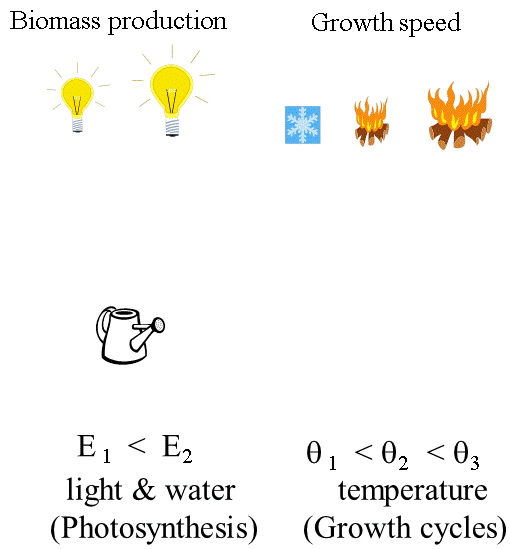GreenLab Course
About modelling
Factors affecting plant growth and modelling
Plant growth results from both endogenous processes and environmental factors.
The endogenous process
-
The endogenous process drives plant structure establishment
Plant structure establishment is the final result of endogenous processes.
Such rules can be simulated with an automaton. Models simulating such organ differentiation are called structural or geometric. They aim to generate the plant structure at various ages, up to detailed geometry allowing 3D representations. The rules are based on botanical architectural notions. Ideally, for a given species, an efficient model defines rules for each axis typology (each physiological age), suitable for a wide range of plant ages and environmental conditions. In the illustrated example the structure is built from five consecutive metamers at the same stage of differentiation. The terminal bud reaches then a flowering stage; the growth is thus determinate (Drawing and animation P. de Reffye, CIRAD) |
 |
Environmental Factors
-
Environmental factors also impact on plant growth.
-
Resources, and more precisely the supply of water and light, affect organ biomass accumulation and thus organ size.
Models relative to these aspects are called functional models. Such is the case of process-based models or crop models.
- Light produces photosynthates via green leaf functioning. Empirically, the effect of incident light is well known. Depending on light intensity, a linear effect can be seen, gradually reaching saturation. Light also has a strong influence on plant plasticity. It can modify plant development by affecting the rules of meristem production. This can be a difficult point for modelling, requiring functional to structural feedback.
- Water is taken up by roots from the root environment and evaporates by transpiration at leaf level. As both transpiration and photosynthesis are strongly influenced by light intensity, a close relation is often seen between crop transpiration and biomass production. Plant transpiration depends primarily on radiation and leaf area. It can be limited by water shortages in the root environment (stomata will close).
The cumulated effect of water transpiration over the long term is often linearly related to plant biomass production.
Modelling biomass production (photosynthesis) is a key point, and mutually benefits from the empirical light effect law and the linear water transpiration / biomass production relation.
However, biomass attribution to a given organ results from a competition between organs. During growth, available biomass will be alloted to a given organ depending on its sink strength.
- Temperature also affects growth.
- In most of plants, the structure development steps are governed by the thermal energy received.
Temperature controls the rate of shoot development and the duration of organ expansion. Within a given temperature range (i.e., when the development rate is linearly related to temperature), there is a linear relationship between the number of phytomers formed on a shoot and the sum of daily effective temperatures received by the plant.
Hence, in advanced models, development cycles are scheduled by thermal time, rather than calendar time.

Environmental factors illustrating the growth dynamics (Drawing and animation P. de Reffye, CIRAD)
Left, an endogenous factor. In the illustrated example, the structure is built from five consecutive metamers at the same stage of differentiation. The terminal bud then reaches a flowering stage; growth is thus determinate.
Middle and right: Environmental factors illustrating growth dynamics. Two levels of resources and three levels of temperature are illustrated.
